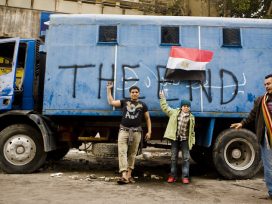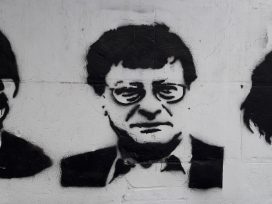Never has a revolution that seemed so lacking in prospects gathered momentum so quickly and so unexpectedly. The Egyptian Revolution, starting on 25 January, lacked leadership and possessed little organization; its defining events, on Friday, 28 January, occurred on a day when all communication technologies, including all Internet and phones, were barred; it took place in a large country known for sedate political life, a very long legacy of authoritarian continuity, and an enviable repressive apparatus consisting of more than 2 million members. But on that one day, the regime of Hosni Mubarak, entrenched for 30 years and seemingly eternal, the only regime that the vast majority of the protesters had ever known, evaporated.
Though the regime struggled for two more weeks, practically little government existed during that period. All ministries and government offices had closed, and almost all police headquarters were burned down on 28 January. Except for the army, all security personnel disappeared, and a week after the uprising, only few police officers ventured out again. Popular committees took over security in the neighbourhoods. I saw patriotism expressed everywhere as collective pride in the realization that people who did not know each other could act together, intentionally and with a purpose.
Undoubtedly this revolution, which is continuing to unfold, will be the formative event in the lives of the millions of youth who spearheaded it in Egypt, and perhaps also the many more millions of youth who followed it throughout the Arab world. Yet while the youth were the driving force in the earlier days, the revolution quickly became national in every sense; over the days I saw an increasing demographic mix in demonstrations, with people from all age groups, social classes, men and women, Muslims and Christians, urban people and peasants – virtually all sectors of society – acting in large numbers and with a determination rarely seen before.
Everyone I talked to echoed similar transformative themes: they highlighted a sense of wonder at how they discovered their neighbour again, how they never knew that they lived in “society” or the meaning of the word, until this event, and how everyone who yesterday had appeared so distant is now so close. I saw peasant women giving protestors onions to help them recover from teargas attacks; young men dissuading others from acts of vandalism; the National Museum being protected by protestors’ human shield from looting and fire; protestors protecting captured baltagiyya who had been attacking them from being harmed by other protestors; and countless other incidents of generous civility amidst the prevailing destruction and chaos.
While world media highlighted uncontrolled chaos, regional implications, and the spectre of Islamism in power, the ant’s perspective revealed the relative irrelevance of all of these considerations. As the revolution took longer and longer to accomplish the mission of bringing down the regime, protestors themselves began to spend more time highlighting other accomplishments, such as how new ethics were emerging precisely amidst chaos. Those evidenced themselves in a broadly shared sense of personal responsibility for civilization –voluntary street cleaning, standing in line, the complete disappearance of harassment of women in public, returning stolen and found objects, and countless other ethical decisions that had usually been ignored or left for others to worry about.
There are a number of basic features that are associated with this magnificent event that are key, I think, to understanding not just the Egyptian Revolution but also the emerging Arab uprisings of 2011. Those features include the power of marginal forces; spontaneity as an art of moving; civic character as a conscious ethical contrast to state’s barbarism; the priority assigned to political over all other kinds of demands, including economics; and lastly autocratic deafness, meaning the ill-preparedness of ruling elites to hear the early reverberations as anything but undifferentiated public noise that could be easily made inaudible again with the usual means.
Marginality
Marginality means that the revolution began at the margins. The Tunisian revolution started in marginal areas, from where it migrated to the capital. And from Tunisia, itself relatively marginal in the larger context of the Arab World, it travelled to Egypt. Obviously the situation in each Arab country is different so far as economic indicators and degree of liberalization are concerned, but I was struck at how conscious the Egyptian youth were of the Tunisian example preceding them by just two weeks.
Marginality appears to have been an important factor within Egypt as well. While much of the media focus was on Tahrir Square in central Cairo, to which I went every day, the large presence there was itself a manifestation of a possibility that suddenly became evident on 25 January, when large demonstrations broke out in 12 of Egypt’s provinces. The revolution would never have been perceived as possible had it been confined to Cairo, and in fact its most intense moment in its earlier days, when it really looked that a revolution was happening, were in more marginal sites like Suez. The collective perception that a revolution was happening at the margins, where it was least expected, gave everyone the confidence necessary to realize that it could happen everywhere.
Spontaneity
Second, in every sense the revolution maintained throughout a character of spontaneity, in the sense that it had no permanent organization. Rather, organizational needs – for example governing how to communicate, what to do the next day, what to call that day, how to evacuate the injured, how to repulse baltagiyya assaults, and even how to formulate demands – emerged in the field directly and continued to develop in response to new situations. Further, the revolution lacked recognized leadership from beginning to end, a fact that seemed to matter most to observers. I saw several debates in which participants strongly resisted being represented by any existing group or leader, just as they resisted demands that they produce “representatives” that someone, such as al-Azhar or the government, could talk to. A common statement I heard was that it was “the people” who decide.
Spontaneity was a key element also because it made the revolution hard to predict or control; and because it provided for an unusual level of dynamism – so long as many millions remained completely committed to a collective priority of bringing down the regime, represented in its president. But it also appeared that spontaneity played a therapeutic and not simply organizational or ideological role. More than one participant mentioned to me how the revolution was psychologically liberating, because all the repression that they had internalized as self-criticism and perception of inborn weakness, was in the revolutionary climate turned outwards as positive energy and a discovery of self-worth. I heard the term “awakening” being used endlessly to describe the movement as a spontaneous emergence from deep slumber, which no party program had been able shake off before.
Further, spontaneity was responsible, it seems, for the increasing ceiling of the goals of the uprising, from basic reform demands on 25 January, to changing the entire regime three days later, to rejecting all concessions made by the regime while Mubarak was in office, to putting Mubarak on trial. Removing Mubarak was in fact not anyone’s serious demand on 25 January, when the slogans condemned the possible candidacy of his son, and only called on Mubarak himself not to run again. But by the end of the day on 28 January, the immediate removal of Mubarak from office had become an unwavering principle, and indeed it seemed then that it was about to happen. Here one found out what was possible through spontaneous movement rather than a fixed program, organization or leadership. Spontaneity thus became the compass of the revolution and the way in which it reached what turned out to be its radical destination.
It therefore proved difficult to persuade protestors to give up the spontaneous character of the revolution, since spontaneity had already proved its power. Spontaneity also appeared as a way by which the carnivalesque character of social life was brought to the theatre of the revolution as a way of expressing freedom and initiative. For example, among the thousands of signs I saw in demonstrations, there were hardly any standard ones (as one would see in pro-government demonstration). Instead, the vast majority of signs were individual and hand-made, written or drawn on all kinds of materials and objects, and were proudly displayed by their authors. Spontaneity also proved highly useful for networking, since the revolution became essentially an extension of the spontaneous character of everyday life, where little detailed planning was needed or possible.
But while spontaneity provided the revolution with much of its elements of success, it also meant that the transition to a new order would be engineered by existing forces within the regime and organized opposition, since the millions in the streets had no single force that could represent them. Most protestors I talked to, however, seemed less concerned about this than with basic demands whose fulfilment, it appeared, would guarantee the more just nature of any subsequent system. Finally elaborated a week after the beginning of the revolution, these demands had become the following: removing the dictator; dissolving the parliament and electing a new one; amending the constitution so as to reduce presidential power and guarantee more liberties; abolishing the state of emergency; and putting on trial corrupt high officials as well as all those who had ordered the shooting of demonstrators.
Civic ethics
Remarkable was the virtual replacement of religious references by civic ethics that were presumed to be universal and self-evident. This development appears more surprising than in the case of Tunisia, since in Egypt the religious opposition is strong and has reached virtually all sectors of life. The Muslim Brotherhood itself joined after the beginning of the protests and, like all other organized political forces in the country, seemed taken aback by the developments and unable to direct them, as much as the government (along with its regional allies) sought to magnify its role.
This, I think, is substantially connected to the two elements mentioned above: spontaneity and marginality. Both these processes entailed the politicization of otherwise unengaged segments, and corresponded to broad demands that demanded abstinence from religious language. In fact, religion appeared as an obstacle, especially in light of the recent sectarian tensions in Egypt, and contradicted the emergent character of the revolution as being above all dividing lines in society, including one’s religion or religiosity.
Like the Tunisian revolution, in Egypt it erupted as a sort of collective moral earthquake. The central demands were very basic, clustering around the respect for the citizen, dignity and the natural right to participate in the making of the system that ruled over the person. If those same principles had previously been expressed in religious language, now they were expressed without mystification or the need for justification through divine authority. I saw the significance of this transformation when Muslim Brotherhood participants chanted at some point with everyone else for a “civic” (madaniyya) state – explicitly distinguished from two other possible alternatives: a religious (diniyya) or a military (askariyya) state.
Priority of the political
A striking development after January 28 was the fact that radical political demands were elevated above all other grievances – including those concerning Egypt’s dismal economic condition. Political demands were clearer than any other kinds of demands; everyone agreed on them; and everyone shared the assumption that all other problems could be negotiated better once one had a responsible political system in place. Thus combating corruption, a central theme, was one way in which economic grievances could be translated into easily understandable political language. In any case, this corresponded to reality, since the political system had basically become a system of thievery in plain daylight. For months before the revolution, virtually everyone had a story to tell about the ostentatious corruption of the business-cum-political elite that benefited most from “the system”. This tended to be a clique clustering around Mubarak’s son. Some of its members were reportedly behind the recruitment of the thugs who terrorized the protestors for two long days and nights on 2 to 3 February.
Autocratic deafness
As everywhere in the Arab World, a key contributing factor was autocratic deafness. The massive undercurrent of resentment that fuelled this volcano was stoked over the years by the ruling elites, whose longevity in office and lack of meaningful opposition meant they had completely lost track of who their people were. They could no longer read them, so to speak. Hence they heard no rumbling before the revolution, and when it erupted they were slow to hear it as anything other than an undifferentiated noise. On 28 January, when all Egypt was in flames and many world leaders had issued some statement of concern, the Egyptian government remained completely silent. Then, at midnight, Mubarak finally spoke, saying the exact opposite of what everyone had been expecting. He thought he was making a major concession, but one which – as any intelligent advisor could have told him – would only be interpreted as a provocation, resulting in several more days of protests.
Then, on 1 February, he made another speech, also thinking that he was making major concessions, although again, it was received by many protestors as the height of arrogance. On his last day in office, 10 February, he outraged almost everyone in the country when, rather than resigning, he simply delegated his powers temporarily to his now equally hated vice president. Enormous crowds converged on the streets and reached the presidential palace on 11 February, and the whole country now appeared determined to exact vengeance on a man so out of touch with such an unmistakable popular will.
That on 2 February some of Mubarak’s supporters found nothing better to do than send thugs on camels and horses to disperse the crowd at Tahrir, seemed to reflect the regime’s antiquated character: a regime from a bygone era, with no relationship to the moment at hand. It was as if a rupture in time had occurred and we were witnessing a battle from the twelfth century. From my perspective in the crowd, it was as if they had ridden through and were swallowed right back into the fold that returned them to the past. By contrast, popular committees in the neighbourhood, with their rudimentary weapons and total absence of illusions, represented what society had already become with this revolution: a real body, controlling its present with its own hands, and learning that it could likewise make a future for itself, in the present and from below. At this moment, out of the dead weight of decades of inwardness and self-contempt, there emerged spontaneous order out of chaos. That fact, rather than detached patriarchal condescension, represents the very best hope for the dawn of a new civic order.





